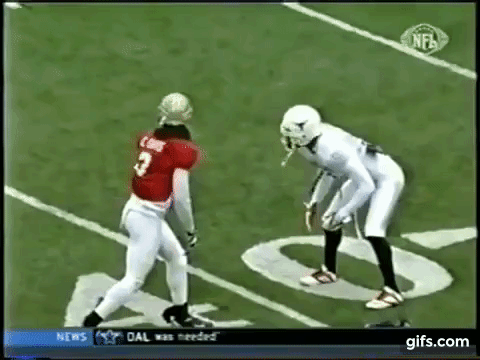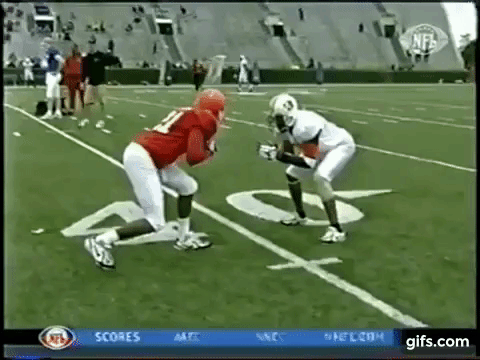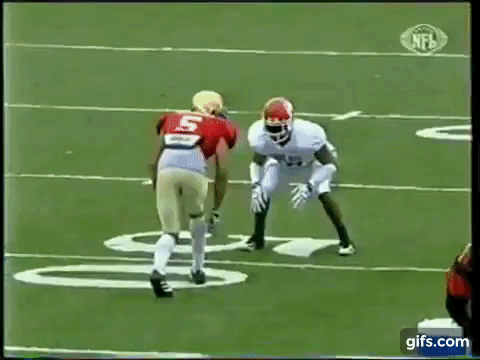Every Friday, Saturday, and Sunday, you’ll notice the corners playing about a yard away from the wide receiver, known as press coverage. What is press coverage?
Press coverage, also known as man coverage, is when the defensive player lines up 1 yard away from the receiver and covers them wherever they go.
This article will show you the different types of press coverage played by football teams.
Press Coverage In Football
Press coverage in football is one of the hardest skills to learn. It requires extreme athleticism, patience, and confidence.
Defensive players will line up 1 yard away from the wide receiver when playing press coverage. When the ball is snapped, they will use a jam technique, keeping their shoulders square and punching the wide receiver’s chest plate.
Players in high school and college can be a bit more physical in man coverage because the rules allow them to be.
In the NFL however, due to physical Pittsburgh Steelers cornerback Mel Blount, the rules are more strict.
The Mel Blount rule is the regulation to ensure no contact after 5 yards. This is an NFL rule made famous, named after physical Pittsburgh Steelers Corner Mel Blount.
https://www.youtube.com/watch?v=-CzZO44-rcU
(Watch on YouTube)
Mel was known for putting receivers on the ground or out of bounds. This forced the competition committee to install the “no contact after 5 yards” rule, known today as the Mel Blount Rule.
Coaches have since adapted to a different style of press coverage.
Playing Press Coverage
Otherwise known as bump and run coverage, press coverage is a type of coverage that’s often played by aggressive teams.
Press coverage was designed to disrupt the route and the receiver’s timing in hopes the pass rush could get to the quarterback before he threw it. This technique is often played in cover 0 and cover 1.
To fully understand press coverage, let’s look at the earliest form of press coverage. From the NFL Operations Manual:
Even though some fans think that rules changes always favor the offense, it’s not true. Many restrictions affect blocking techniques and other offensive tactics. As was noted in a 2012 Competition Committee report, the 1978 illegal contact rule “simply restored the traditional relationship between the receiver and the defender.
Defenders ran with receivers without contact until the 1960s, when they began using the “bump and run” technique to move receivers off their routes. That technique took advantage of an anomaly in the offensive and defensive pass interference rules: A nonblocking receiver couldn’t initiate contact with the defender from the time the ball was snapped, but the defender could initiate contact anytime before the pass was thrown.
With the illegal contact rule, beyond 5 yards downfield “the defender has the same obligation to avoid contact with the receiver as the receiver has to avoid contact with the defender,” the committee said. “We have never viewed that as favoring the offense.”
Press man requires extreme patience to play.
We’re going to show you the 3 main types of press man coverage that are played by all football teams. Each technique varies based on the skill of the defensive player or defensive back.
No Contact Mirror Technique Press Coverage

This technique is most common in the NFL due to the speed and quickness of the WRs.
Corners often shuffle away from the play, give ground, and anticipate a WR cut. The key to this coverage is to ensure your shoulders stay square as long as possible.
Defensive backs get into trouble when they’re too quick to jump out on a receiver’s first move, and they end up getting their hips flipped around.
Past corners such as Deion Sanders and Darrelle Revis were great, mainly because of their discipline to stay on the hip of receivers while also having tremendous cover skills.
One Hand Jam Press Coverage

We often see this press technique in college as it’s safer than the two-hand jam.
It allows the defensive back to keep hips square and balanced if the wide receiver knocks it away.
One problem with the one-hand jam is defensive backs often don’t move their feet when they jam. In the video above, the corner does an excellent job jamming with one hand. However, he’s back on his heels.
A good receiver will use the space he gathers to stack back up and gain vertical leverage.
Two Hand Jam Press Coverage
The two-hand jam is a high-risk, high-reward type jam.
The high risk comes from shooting two hands at the wide receiver. The wide receiver can quickly gain vertical leverage if the defensive back is not disciplined by keeping his hips square to the defender.
Two key points that are extremely important when playing jam coverage:
- Contact Point
- Footwork

In the first clip, the defensive back gets a great jam on the receiver with two hands and continues to ride him up the sideline. He does a great job sliding his feet and staying square, allowing him to get on the back hip and place himself between the ball and the quarterback.
He may have passed the footwork test. However, the contact point isn’t great. His head dips forward slightly when he makes the initial punch. This means his body weight is leaning forward.
When a defensive back is leaning forward, it is easier for the wide receiver to wash their arms away and get vertical.

The second clip is a little different. The corner makes decent contact and maintains body control. The only issue is his body and leverage are too far upfield – therefore, the receiver undercuts him, and he has no chance.
He’s off-balance as he transitions upfield mainly because of his first two initial hop steps. When he turns his hips and gets into his transition, his feet are together. This forces his next step to be an over-stride, which puts him off balance. The receiver times it up perfectly and washes him away at this exact moment.
Other Types of Press Coverage
Press coverage has been innovated from man coverage and zone coverage. Teams are pressing in all types of coverages, including:
- Cover 2
- Press/Bail Cover 3
- Press/Bail Cover 4
Cover 2 press allows the corner to be physical with the wide receiver at the line of scrimmage and still bail into the flats.
Press/Bail Cover 3/4 allows corners to be physical at the line to bail to the deep third or fourth. This gives athletic corners the advantage of being physical but still having the proper footwork to cover vertical routes.
This is also a common bluff for the defensive backs, tricking the quarterback into thinking they have the receiver on an outside go route when the defensive back is bailing to it.
If you’re looking to beat press coverage, we recommend reading this article next.
If you’re looking to learn the complexities of playing defensive back, we recommend you check out our Defensive Back University course. You will learn in complete detail how to play the position effectively.
Keep Learning
Below are more articles to help you learn about defensive backs.
What Does A Safety Do In Football? Learn Here
What Is A DB In American Football? Explained
Press coverage is mainly played to disrupt the route timing of the offense. Offensive players must use their hands and feet to get away from press coverage.
Press coverage is often played from corners or nickel backs in man coverage.
What type of press coverage do you play? Do you have a different style of teaching it? If so, we’d love to hear about it in the comment section below!

